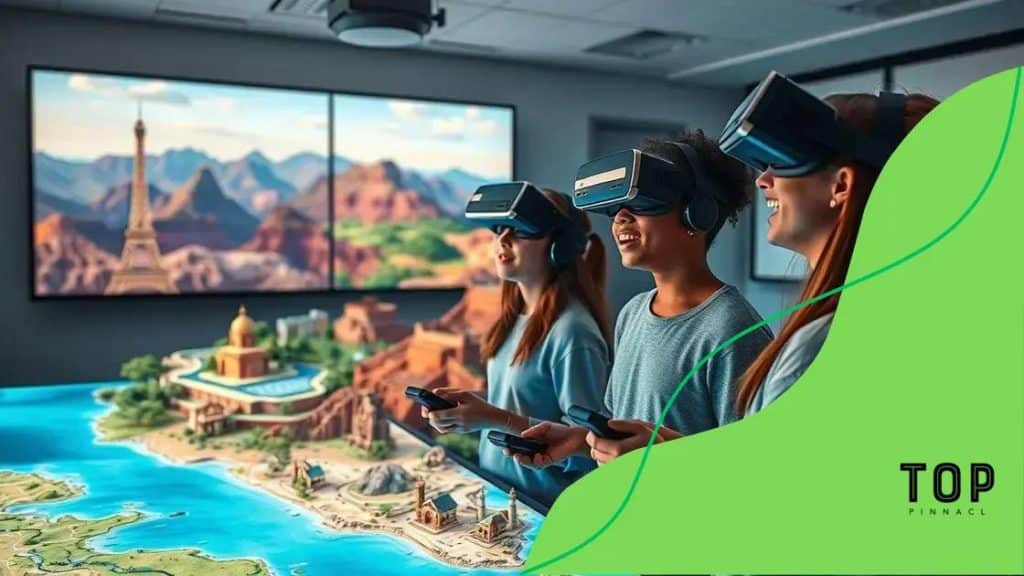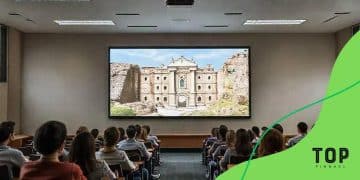Virtual field trips 2025: exploring the world from home

Virtual field trips in 2025 will utilize advanced technologies like VR and AR to create immersive, interactive learning experiences, enhancing education by making global exploration accessible from the classroom.
Imagine exploring the wonders of the world without leaving your home. Virtual field trips 2025 are shaping the future of learning, making global exploration accessible and engaging. Let’s dive into how these innovative experiences can enhance education and spark curiosity.
Benefits of virtual field trips for education
Virtual field trips are an exciting way to enhance education. They allow students to explore new places while learning from the comfort of their classroom or home. Benefits of virtual field trips for education include increased engagement, accessibility, and interactivity.
Enhancing Student Engagement
When students participate in virtual field trips, they often feel more connected to the material. These immersive experiences can capture their attention in a way traditional lessons may not. By introducing elements like videos and real-time interaction, educators can inspire curiosity and motivate students to learn more.
Accessibility for All
Accessibility is another significant advantage. Students who may have difficulties attending physical field trips can still experience valuable learning opportunities through virtual platforms. This inclusivity ensures that all students, regardless of circumstances, get a chance to explore.
- Allows participation from various locations
- Overcomes physical barriers to education
- Caters to different learning styles
Moreover, these trips are often more affordable. Schools can save on transportation and entry fees, allowing more resources to be focused on the learning experience itself. Educational institutions can provide richer content without the logistical challenges of travel.
Interactivity and Learning Outcomes
Virtual field trips promote interactivity. Students can ask questions in real-time and respond to prompts during the trip. This interaction boosts retention and fosters critical thinking. With the integration of technology, like virtual reality, students can feel as if they are truly there, enriching their understanding of the subject matter.
Overall, the advantages of virtual field trips are clear. They make education more engaging and accessible while promoting a deeper understanding of the material. Incorporating these innovative learning experiences can transform how knowledge is delivered in schools.
Top virtual field trips to explore in 2025
As we look towards 2025, many exciting virtual field trips await eager learners. These trips offer students the chance to explore new cultures, historical sites, and natural wonders, all from their classrooms.
Explore Iconic Landmarks
One of the best options for virtual exploration is touring famous landmarks. Students can visit places like the Great Wall of China or the Colosseum in Rome. Through guided virtual tours, they can learn about the history and significance of these remarkable structures.
Visit Nature Reserves
Nature lovers can delve into captivating ecosystems with a virtual field trip to the Amazon Rainforest or the Great Barrier Reef. Students can observe unique wildlife and learn about conservation efforts. These experiences create a sense of connection to our planet while educating students on environmental issues.
- Live-streamed animal encounters
- Interactive lessons on ecosystems
- Opportunities to ask experts questions
Additionally, virtual museum tours are not to be missed! Students can wander through the Smithsonian National Museum of Natural History and view exhibits showcasing ancient artifacts and incredible biodiversity. This kind of access encourages critical thinking as students analyze art and history.
Engaging Cultural Experiences
Cultural immersion is another fantastic aspect of virtual field trips. Students can virtually visit local festivals around the world. They can experience traditional dances, food, and customs from the comfort of their classroom.
These trips also often include student interaction, where they can share their own culture and learn from peers globally. This exchange promotes understanding and appreciation of diversity.
How to effectively use virtual field trips in the classroom

Using virtual field trips effectively in the classroom can transform traditional learning. Teachers can engage students in new and exciting ways. Strategies for incorporating these innovative experiences are essential.
Planning Ahead
To start, teachers should carefully plan each virtual trip. They need to choose destinations that align with their curriculum. Additionally, creating pre-trip activities can help set expectations and build excitement. Students can research the location or topic, which prepares them for the experience.
Interactive Components
During the trip, it’s vital to have interactive components. Students can participate in live Q&A sessions or collaborative activities. This kind of engagement allows them to connect with the material in real-time. Educators can encourage discussions or reflections during the trip, fostering deeper understanding.
- Use polls or quizzes to gauge understanding
- Encourage note-taking on key observations
- Facilitate small group discussions after the trip
After returning from a virtual field trip, assigning follow-up activities is beneficial. These can include reflection essays, presentations, or creative projects that allow students to apply what they’ve learned. Students might analyze specific aspects of the trip or create art inspired by it.
Incorporating Technology
Integrating technology is crucial for making the experience enriching. Using tools like virtual reality or 360-degree videos can enhance the immersion. Teachers should also leverage online resources that complement the trip, such as videos, articles, and guest speakers. This combination of resources enhances learning and retention.
Ultimately, the goal is to create a seamless blend of virtual exploration and classroom learning. Students should feel involved and inspired by their virtual field trip experiences. By employing these strategies, educators can open new avenues to knowledge and discovery.
Technology required for an engaging virtual field trip
For a successful virtual field trip, the right technology is essential. Having the proper tools makes the experience engaging and interactive for students. In this section, we will explore the vital technologies needed to enhance virtual learning.
Devices and Connectivity
First, quality devices are necessary for all participants. Students should use laptops, tablets, or desktops with reliable internet access. A stable connection is crucial for seamless interaction during the trip. Schools and educators need to ensure that all students have access to devices, whether through school resources or personal ones.
Audio and Visual Equipment
Effective audio and visual equipment can enhance the learning experience significantly. Headsets with microphones enable clear communication between the guide and students. High-definition webcams can provide a better view of the locations being explored. Furthermore, utilizing virtual reality (VR) headsets can create immersive experiences that make students feel like they are actually there.
- VR headsets for immersive experiences
- Quality microphones for clear communication
- High-resolution cameras for a better view
Another key aspect is the software used for virtual field trips. Live streaming platforms, interactive software, and virtual reality applications can help facilitate engaging experiences. Educators should choose platforms that allow for interaction, such as polls or Q&A sessions, to keep students actively involved.
Educational Resources
In addition to hardware and software, having access to educational resources is important. Teachers can use online materials that complement virtual trips, such as worksheets, quizzes, and multimedia content related to the destination. This added information can deepen students’ understanding and enhance their overall experience.
Setting up the right technology is crucial for an engaging virtual field trip. By ensuring all students have access to devices, using quality audio and visual equipment, and integrating interactive software, educators can create rich and educational experiences that captivate students’ interest.
Future trends in virtual travel experiences
The world of virtual travel is constantly evolving, and it’s exciting to look at future trends that will shape these experiences. Innovations in technology are making virtual trips more immersive and accessible for everyone.
Enhanced Virtual Reality
One major trend is the advancement of virtual reality (VR) technologies. VR headsets are becoming more affordable and user-friendly. This means that more people can enjoy immersive travel experiences from their homes. As the technology improves, we expect even more realistic graphics and interactivity. Imagine walking through ancient ruins or diving into the ocean to explore coral reefs without ever leaving your chair.
Augmented Reality Experiences
Another trend is the rise of augmented reality (AR). AR combines real-world environments with digital information. Users can point their devices at a location to see overlays of information, videos, or animations. This might enhance traditional tourist destinations by providing richer historical context or fun facts, making the experience more engaging.
- Interactive features that allow personal exploration
- Location-based content delivery
- Sharing experiences with friends through social media
Additionally, social interactions during virtual trips are becoming more prominent. Platforms may allow users to travel together virtually, sharing experiences in real time. This social aspect mirrors physical travel, creating a sense of community among participants who can discuss what they observe as they explore.
Personalized Travel Experiences
Another important trend is personalization. Virtual travel platforms are beginning to use artificial intelligence to tailor experiences to individual preferences. By analyzing user behavior, these systems can suggest destinations or activities that match users’ interests. This means that every virtual trip can feel unique and specially designed for each traveler.
Integrating learning components within virtual trips is also gaining popularity. Educational institutions can offer courses or curriculum-based trips that allow students to learn about different cultures or historical sites interactively. This approach encourages deeper engagement and retention of knowledge.
FAQ – Frequently Asked Questions about Virtual Field Trips
What are virtual field trips?
Virtual field trips are online experiences that allow students to explore various locations and learn about them without leaving their classrooms.
How can technology enhance virtual field trips?
Technology enhances virtual field trips through immersive experiences, using tools like VR and AR, and allowing for interactive learning with real-time engagement.
What are some benefits of using virtual field trips in education?
Benefits include increased engagement, accessibility for all students, and the ability to connect learning with real-world experiences.
How can educators effectively implement virtual field trips?
Educators can plan ahead, use interactive components, and integrate follow-up activities to ensure a valuable learning experience.






